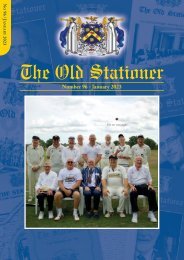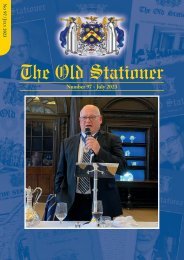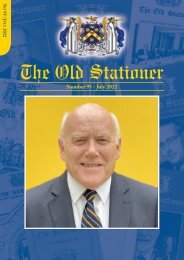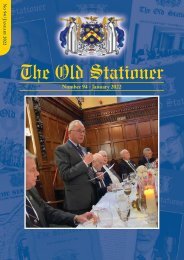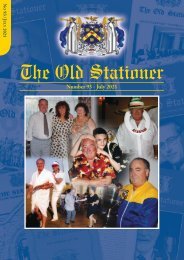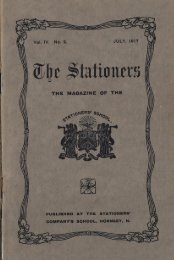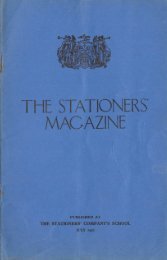OSAmag80
Create successful ePaper yourself
Turn your PDF publications into a flip-book with our unique Google optimized e-Paper software.
WHY WE SPEND NEARLY HALF<br />
THE YEAR IN LANZAROTE<br />
I was persuaded that I should not continue to put Brenda<br />
through the journey to Australia. Lanzarote is less than four<br />
hours away from Stansted. After ten years as geriatric gypsies<br />
trying to see how far we could roam it was time to settle down.<br />
The first try to reduce the travelling was achieved by finding<br />
a studio apartment for rent in Puerto del Carmen overlooking<br />
the harbour. We went to the same place twice a year for late<br />
autumn and late winter breaks. Unfortunately, I made some<br />
flattering comments on the website. The result was that<br />
somebody booked it for the October period before we set out<br />
for the February break in 2013.<br />
The solution was to seek our own place in the sun. Our luck<br />
held, we were offered a shabby, depressed two bedroom<br />
apartment at a very modest price by a local bank trying to<br />
recover a debt. We were taken to inspect it by an agent who<br />
told us that it was available but the price was not negotiable,<br />
up or down! We both agreed that it was a horrible mess but<br />
Brenda said "it needs TLC".<br />
So I offered the agent the asking price, which was accepted.<br />
The agent then gave us the names and phone numbers of<br />
tradesmen who could help us to provide the TLC. Eighteen<br />
months down the line the process is being completed while<br />
we are back in the UK. We have a spacious, elegant and<br />
modernised two bedroom apartment (72 square metres) with<br />
a patio (plus small sea view) and a forecourt, in the heart of<br />
the old town of Puerto del Carmen.<br />
We were away from the UK rather often and our UK property<br />
was showing signs of being neglected so we sold up and<br />
moved to a retirement complex in Saffron Walden, much<br />
closer to Stansted. The garden is maintained under contract<br />
and the manager lives in the flat above ours. Last year we<br />
spent 25 weeks in Lanzarote and we will do the same in this<br />
and subsequent years. There are many social events in the UK<br />
that we like to attend and we can avoid the complications<br />
which would arise if we go past 182 days in Lanzarote,<br />
including applying for residency which is not realistic.<br />
We now have the time to explore Lanzarote to discover some<br />
of its geography and history. It is said to be the first of the<br />
Canary Islands to explode from the Atlantic Ocean millions<br />
of years ago. In current terms it is the fourth largest island in<br />
the group and the closest to Africa, being 125 km from<br />
Saharan Morocco. The population is about 135,000 supporting<br />
a million tourists a year. It has a very pleasant climate (except<br />
mid-July to mid-September when it can be very hot). The<br />
rainfall is 140mm per annum - yes that is less than 6 inches!<br />
Lanzarote is a very barren land but its arid wastes are<br />
spectacular and such agriculture as occurs is a tribute to the<br />
initiative and cunning of the farmers. The local fishermen<br />
make a good living. The tourist industry discovered Lanzarote<br />
in 1960 and probably peaked in 1982. The worldwide<br />
financial crisis of recent years produced a major downturn<br />
here as elsewhere.<br />
There is some reference to Arabs visiting the island in the<br />
tenth century. By the end of the 13th century many ships<br />
T h e O l d S t a t i o n e r - N o 8 0<br />
AS FAR AS YOU ROAM<br />
visited the Canary Islands but Lanzarote would not have been<br />
a preferred destination as there have never been rivers. The<br />
Spanish and Portuguese disputed ownership until the Treaty<br />
of Alcazovar 1479 finally put the Spanish in control. Following<br />
the discovery of the Americas there was substantial shipping<br />
through the Canary Islands and Lanzarote was periodically<br />
under attack from French, English and Dutch pirates. Early<br />
in the 17th century 5000 Arabs took Lanzarote with an<br />
invasion by 60 vessels. In 1730 the island had a small<br />
population, with the economy based on agriculture and cattle<br />
rearing.<br />
On the evening of September 1st, about 11 km from the town<br />
of Yaiza the earth opened and the volcano of Timanfaya rose<br />
to 500 metres above sea level and lava flowed from the first<br />
and subsequent eruptions across the island until April 1736.<br />
This suffocated the livestock and covered the arable land in<br />
deep lava and produced many more volcanoes. Some thirty<br />
years later a drought for five years reduced the population by<br />
more than 2000 through hunger and thirst. In the 19th<br />
century various epidemics further reduced the population and<br />
the final volcanic eruptions in 1824 preceded yet another<br />
drought, which finally broke in 1847 leaving the island in its<br />
most depressed state.<br />
Modern technology has provided power from the sun and<br />
some drinking water from the ocean. Some of the beaches<br />
have been topped up with sand imported from the Saharan<br />
desert. Life for the farmers remains very hard. Water is very<br />
expensive and said to be not entirely salt free, although it<br />
tastes OK. They manage to grow vines and figs in hand made<br />
holes in the ground protected by walls of volcanic stones,<br />
which catch dew and occasional rain. There are some inland<br />
sandy areas supporting onion growing and some tomatoes and<br />
water melons but no one would claim they have any chance of<br />
making the place self-sufficient in the near future. We have<br />
had a look round and done some research and now are<br />
hooked. Four or five return tickets a year looks like the way<br />
forward. The climate is agreeable and the multiracial<br />
population in our area has been very friendly. For the time<br />
being we have the best of both locations. We can return<br />
frequently to our new neighbours in Saffron Walden to<br />
develop a social life there as well.<br />
Peter Engledow<br />
Dear Geraint,<br />
THREE PEAKS REPORT<br />
R.A.Griffiths@kent.ac.uk<br />
5th September 201422:43:41<br />
Great to meet up at Whipsnade recently. Here is the promised<br />
article about our Three Peaks walk in June, together with the<br />
extract from The Stationer 1975.<br />
The latter has some other interesting pictures (eg: me in the<br />
school play, Mike Brookes, Richard Comerford and Sean<br />
Leonard in the School 1st XI, and you John Watson and John<br />
Young in the staff football team - I can scan these if you'd like<br />
them). Also some Three Peaks photos. Let me know if you<br />
would like any further info.<br />
Best regards,<br />
Professor Richard A Griff iths 1968-75<br />
35



